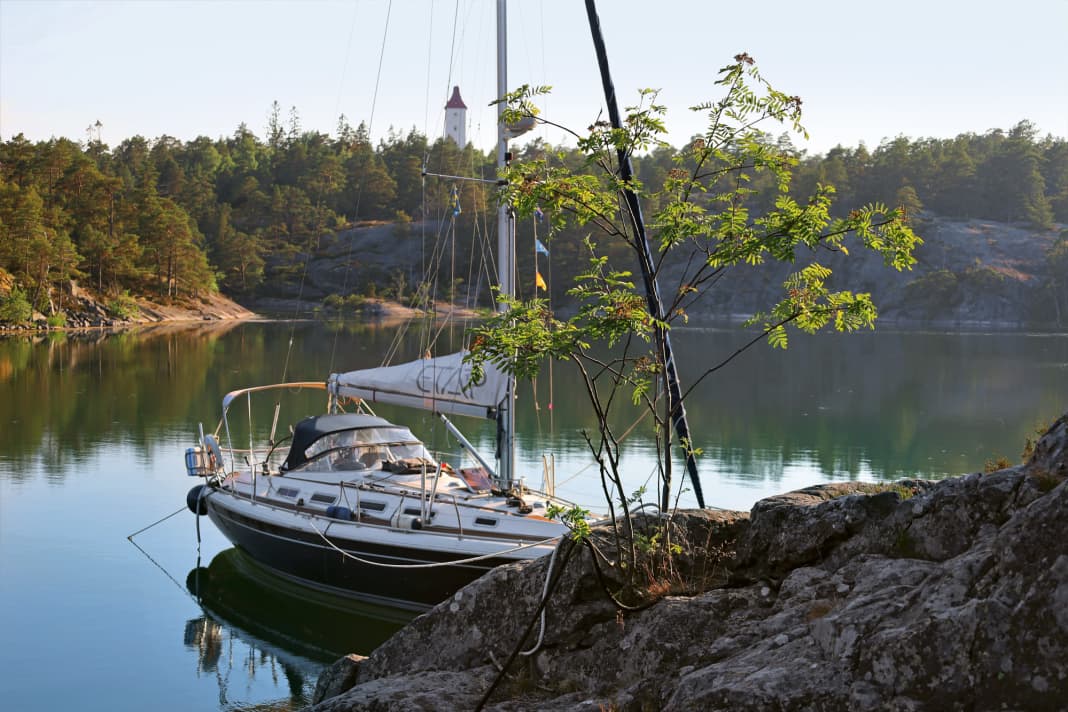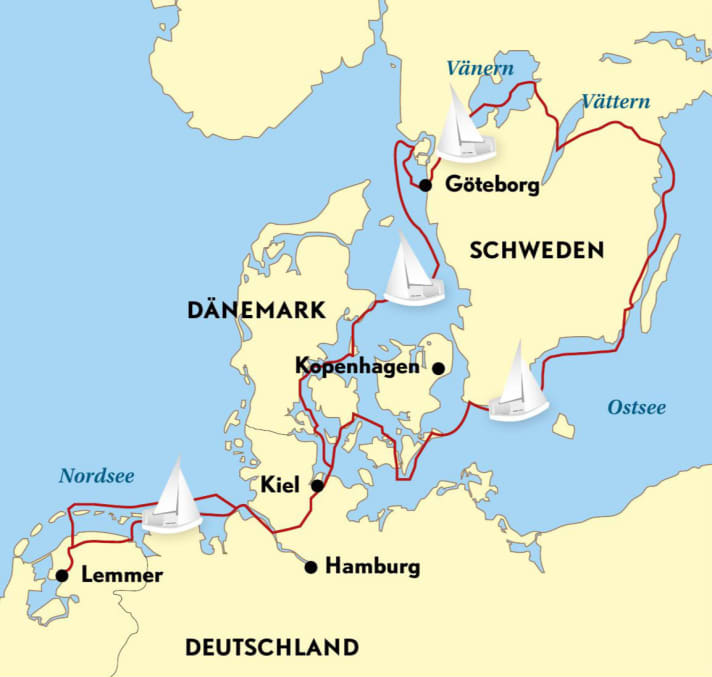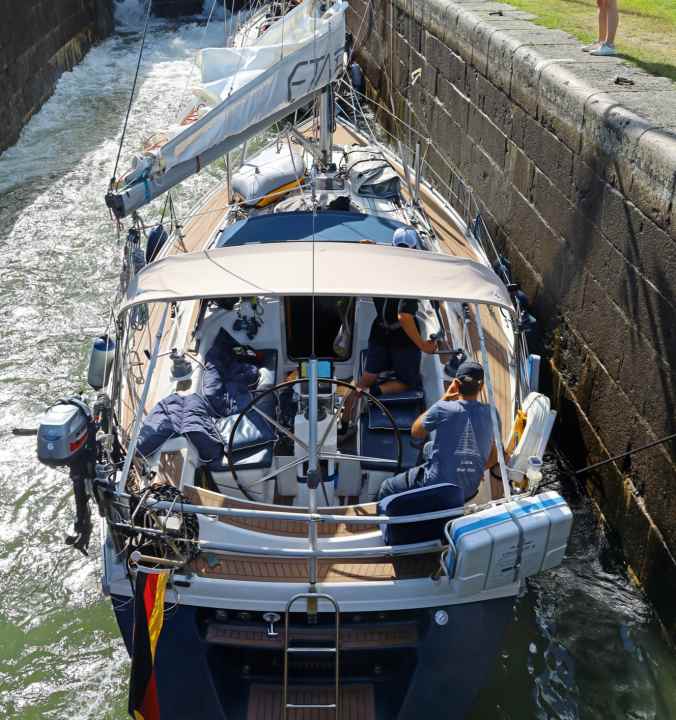





The "Luna" glides along the Swedish east coast with its sails shining in the sun, the crystal-clear water reflecting the cloudless sky. A relaxed speed of five and a half knots is almost too fast for the beautiful archipelago landscape. Two hours later, the anchor drops off the island of Harstena, and shortly afterwards the entire crew, including the on-board dog Sky, are in the dinghy on their way ashore. The crew are my parents Maite, 55, and Uwe, 54, my brother Janik, 23, and me, Annika, 19, who have been travelling together for several weeks.
On land, we explore the archipelago. Once you have climbed the highest point of the island, the small settlement at your feet with the typical Scandinavian red wooden houses, the greenery and the narrow sound that winds through the village almost looks like something out of a Bullerbü film.
I am now sitting here and enjoying the fantastic view, trying to memorise this moment forever. When I sat here 17 years ago, when I was two and a half, it didn't work so well with memorisation. It's a shame on the one hand, but if I remembered the trip back then like the rest of my family, it probably wouldn't have come to this new edition.
From the IJsselmeer via the Baltic Sea to Sweden
Because that's exactly what this trip is: a new edition. We also had around three months back then and took the same route: from the IJsselmeer to the Baltic Sea and then to the Swedish coast and through the Göta Canal. The only difference was that this time the impetus came from me, instigated by the eternal "Anni, do you remember ...?" from my parents. No, of course not! I wanted to finally be able to have my say when my family raved about the archipelago and the canal trip again.
In fact, my parents and my brother are quickly persuaded to go along with the plan. We all manage to make time for it. This time, however, we will be travelling the 1,750 nautical miles in our Etap 39s. Unlike the first time, when we still had an Etap 32i, Janik and I now each have our own double cabin in the stern.
At the beginning of June 2022, the longed-for day has finally arrived: cast off from our home port of Lemmer on the IJsselmeer. From here, we will sail along the Staande Mastroute to the North Sea and on towards the mouth of the Elbe. The Kiel Canal is always a real milestone at the beginning of our summer trips, as it marks the start of a holiday on our favourite sailing area, the Baltic Sea. And this time too, after an exciting North Sea passage, the feeling finally sets in that this year our dream is coming true and we are getting closer to our dream destination of Sweden with every mile.

The Sweden cruise is intended to help people get over the flood disaster on the Ahr
All the harder we are hit by the reality that a boat mechanic in Laboe tries to explain to us: We're not going anywhere with our engine! We've been a bit worried about the engine for a few days now, but we thought the problem could be solved with a single spare part. The bad news really knocks us for six. We need a new engine, and fast, otherwise our journey will be over before it has begun.
But: "Nothing is possible in less than a month," say everyone we ask. A quick replacement seems unrealistic - and this after we had overcome all the difficulties that accompanied and burdened us during the preparations for this trip. You have to realise that we were among those who had been badly affected by the Ahr Valley flood disaster a year earlier: our house was uninhabitable for years, our personal belongings destroyed by the floods, our hometown a field of rubble. The "100 days of freedom", as we call our project, should also help us to get over all this and gain a little distance.
So a real stroke of luck is needed. And it happens: a boat mechanic in Laboe is so moved by our story that he makes the impossible possible. He drops everything else and installs a new Volvo Penta engine for us within no more than four days, which he procures from a dealer on Fehmarn. After a week's delay, we are able to continue our cruise.
Finally: the "summer in the archipelago" feeling is here
We can fly the Swedish host country flag over the Danish town of Spodsbjerg and two subsequent longer trips, and the summer-in-the-archipelago feeling is not long in coming: long, late sunsets in a cloudless sky, strawberry cake, irresistible ice cream and the aforementioned wooden houses. Fittingly, the other day is Midsummer on 21 June, so there are also garden parties and Swedish women in white dresses with home-made flower wreaths.
The trip not only takes them to fantastic destinations, it is full of impressions, encounters and experiences. And it brings the family even closer together
It is equally important for all of us to consciously enjoy and reflect on our experiences. We each do that in our own way. My father is passionate about taking photos with his system camera, Janik shoots films with his action cam. My mum uses her artistic talent to create a travel diary and I have resolved to take a photo every day with my Polaroid camera, capturing a characteristic or memorable moment. These pictures gradually fill the walls and bulkheads of my aft cabin, so that the first thing I see in the morning is all the memories I have already made.
The eastern Swedish archipelago lures us further northwards. We take one or two 80-mile turns until we reach Älö, an anchorage that left a lasting impression on the others. We had a photo collage of the 2005 trip hanging in our house, which I had been looking at longingly since I was a little girl, trying to imagine what the moment and the surroundings were like when the pictures were taken. Including Älö.
Imagination and reality come together in Älö
And now I'm here! Imagination and reality come together. The place really is as dreamlike as I had imagined: a sheltered anchor bay, surrounded by knobbly, wooded granite, which leaves space for a handful of falun-red Swedish houses in a few bare spots. A place of tranquillity, far away from the hustle and bustle. However, the infrastructure is also poor. You need to know that it is often a long way to the nearest petrol station and that spare parts, gas bottles and other things you might need should be on board.
The village of Harstena mentioned at the beginning is also one of our favourite destinations. It once emerged from a seal trawlers' settlement. Today it has only a few permanent residents. Nevertheless, a very lively midsummer festival took place here in 2005, which I can vividly imagine in this place. Young and old danced and sang around the large midsummer pole on the meadow in front of the old village school, the girls and women wore woven flower wreaths on their heads.
The gateway to the Göta Canal, the small town of Mem, which we reach days later, is the beginning of a new, exciting chapter of this journey for us. The 190 kilometre long "blue ribbon" that runs east-west through Sweden is proudly described by many Swedes as the construction of the millennium. And rightly so, in my opinion.
The Göta Canal as a special part of Sweden
"Have a nice summer!", the lock keeper calls after us as we leave the first lock. And really, I can hardly imagine a better place for a nice summer. Wilfried Erdmann put it very aptly in his book "I grasp the wind". In it he writes: "A week of pure landscape followed. For many sailors, this stretch of canal is the trip of a lifetime. Understandably so. It is a particularly fascinating part of Sweden."

There are numerous places along the route that are associated with memories from 2005 that have become second nature even to me, although I only know them from stories. Borensberg, for example, where we stopped off at the famous "Göta Hotell". Or Vadstena, where we children went crayfish fishing with our dad in the pouring rain. Or Sjötorp, from where we went on a long cycle tour along the canal.
Of course, the 67 locks between Mem and Gothenburg are also very impressive. Even today, my parents can still vividly recount the challenge of having to look after two lively toddlers on board alone - one person has to be dropped off on land before the lock - while at the same time having to look after the lines. Even back then, my parents could not confirm the prejudice of the "divorce canal", as the Swedes like to call it: With good fender management and consultation, the locks can be mastered with confidence.
Locks on the canal, sailing on Vänern and Vättern
Nevertheless, locking the locks is much more relaxed with our current full crew of four. We are even relaxed about the infamous seven-person lock staircase in Berg. In fact, it's a pleasure to pass through, as it allows us to experience the surroundings and socialise with our fellow countrymen even more intensively. The lock marathon also helps us to develop as a crew. We take turns with the manoeuvres, each of us taking on a different position.
And I can dispel another preconception: the eternally long canal is anything but boring. And it is also very good for sailing. More than half of the 190-kilometre route across Sweden consists of lakes, some of which are very large, including Vänern and Vättern.
These are fantastic sailing areas. And even the total of around 90 kilometres of canal on which we have to motor are extremely entertaining. Even our onboard dog Sky agrees. Visibly satisfied, he takes his place on the foredeck on every departure. From there, he can keep a close eye on what is happening on the canal bank and on board.
In direct comparison to the past, the pastime today is of course partly different. Instead of a fishing trip, we now favour a tour of the castle. And the "Lion King" role-playing game on suitable rocks, in which we could lose ourselves for hours as children, has now given way to other activities. However, many things have remained the same over the 17 years: the visit to the Göta Hotel and the cycle tour along the former towpaths on the canal. And none of us would want to miss out on swimming and snorkelling in the crystal-clear waters of Vänern and Vättern.
The Göta Canal is a total work of art
The special atmosphere of the canal captivates us right from the start. The waterway is a kind of synthesis of the arts, combining the romance of Swedish nature, idyllic places and impressive cultural history. What's more, the list of things to do along the route is almost endless - making it ideal for a family holiday.
The final stop on our inland journey through Sweden is Gothenburg. The vibrant city with its 580,000 inhabitants doesn't really want to join the long list of rather small places we have visited before. Nevertheless, the metropolis impresses us with its architecture, pleasant flair and not least the wide Östra Hamngatan, which reminds us a little of the Champs Élysées in Paris. What also characterises Gothenburg is the fantastic archipelago right outside the city. After a day of sightseeing, we can no longer resist and cast off - heading for Marstrand.

As so often before, the Western Archipelago captivates us with its colourful wooden houses, narrow sounds, numerous inhabited islands and seals resting on the rocks. Deep blue water in between. As soon as we have enough wind in our sails, the engine stops. Only the gentle lapping of the waves against the hull can be heard as "Luna" glides weightlessly through the water. It feels good to be sailing properly again. All too soon we reach Marstrand.
Farewell to Sweden in Marstrand
The lively city can be seen from afar thanks to the mighty Carlsten Fortress. Swedish sailors celebrate the summer here. The harbour is packed with boats, including some fantastic regatta yachts. The car-free streets invite you to take a stroll, lined with picturesque wooden houses in beautiful pastel colours.
We stay for a few days, then it's time to turn the bow back south for good. With a heavy heart, but with countless invaluable memories in our luggage, we slowly make our way home. And it is still full of highlights. Along the route, for example, lies Anholt, the most remote island community in Denmark. In his book "The Colour of the Sea", Jan von der Bank writes about his hero Ole Storm: "In the late afternoon sun, the sea off Anholt shimmered in all the colours that Ole loved most. Far out, the dark, calm blue-green of the deep water, which gradually changed to an ever brighter green as the bottom became shallower, until it glowed an almost transparent turquoise in front of the beach, streaked with the silver of the waves breaking on the shore. A fairytale, radiant colour gradient that Ole hadn't seen in this beauty for a long time." There is no better way to describe it.
Denmark and the Schlei also offer highlights
Further south, we even discover an as yet unknown pearl of the Danish archipelago: Bogense is fairytale-like. Maybe that's why the statue of Hans Christian Andersen is there. Our last stop on the Baltic Sea and also our last great new discovery is Maasholm on the Schlei. From here, we travelled in one go to Rader Insel in the Kiel Canal. Eight hours later, the North Sea returns the next day. With the wind in front of us and the current running with us, we rush over the ground to "Alte Liebe" at a speed of ten knots.
There, in Cuxhaven, we are blown in for a few days at the end of our journey. It's like taking a short break before returning to everyday life. We realise that perhaps the most valuable thing of the past three months was the "time" factor: time for each other and for ourselves. For books and conversations, for discoveries and relaxation. You don't just have time, you have to take it! It doesn't have to be 100 days.
Annika May

